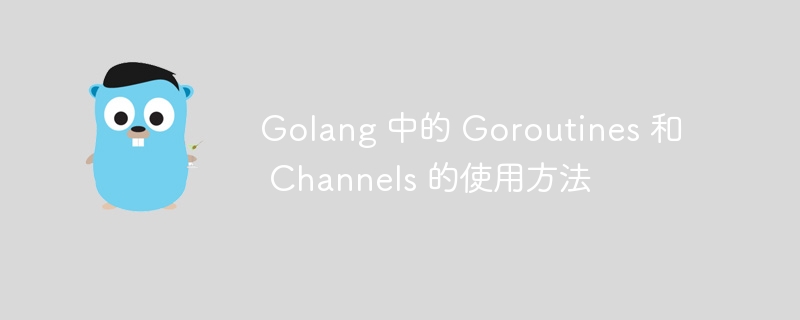

How to use Goroutines and Channels in Golang
Golang is a high-performance programming language that is particularly suitable for handling concurrent tasks. In Golang, Goroutines and Channels are two very important concepts that can help us achieve concurrency and collaboration.
Goroutines are the basic unit of concurrent tasks in Golang. They are lightweight threads. Compared with traditional threads, Goroutines are very cheap to create and destroy, and thousands of Goroutines can be easily created. By using Goroutines, we can perform multiple tasks at the same time and improve program performance.
The following is an example of using Goroutines:
package main
import (
"fmt"
"time"
)
func task(id int) {
for i := 0; i < 5; i++ {
fmt.Printf("Goroutine %d: %d
", id, i)
time.Sleep(time.Millisecond * 100)
}
}
func main() {
for i := 0; i < 3; i++ {
go task(i)
}
// 保证 main 函数不会结束
time.Sleep(time.Second * 1)
}In the above example, we created three Goroutines to execute the task function. Each goroutine prints its own id and an incrementing number. We use the time.Sleep function to pause each Goroutine for a period of time to observe the effect of concurrent execution.
Run the above code, you will see output similar to the following:
Goroutine 0: 0 Goroutine 1: 0 Goroutine 2: 0 Goroutine 0: 1 Goroutine 1: 1 Goroutine 2: 1 ...
As can be seen from the output, the three Goroutines are executed at the same time, and there is no order between them. This is the power of Goroutines. They can be executed concurrently in different threads, thereby improving the execution efficiency of the program.
To communicate between Goroutines, we can use Channels. Channel is a type-safe pipe that can be used to pass data and synchronize the execution of Goroutines.
Here is an example using Channels:
package main
import "fmt"
func sum(numbers []int, result chan int) {
sum := 0
for _, number := range numbers {
sum += number
}
result <- sum
}
func main() {
numbers := []int{1, 2, 3, 4, 5}
result := make(chan int)
go sum(numbers[:3], result)
go sum(numbers[3:], result)
x, y := <-result, <-result
total := x + y
fmt.Println("Total:", total)
}In the above example, we defined a sum function that receives a slice and a Channel. The sum function calculates the sum of the numbers in a slice and writes the result to the Channel.
In the main function, we create a Channel and use two Goroutines to calculate the sum of the first half and the second half of the slice respectively. We use the <- operator to read the result from the Channel and add the results of the two sums together.
Run the above code, you will see the output:
Total: 15
Through Channel, we can achieve data sharing and communication between Goroutines. It ensures synchronization between Goroutines so that concurrently executing Goroutines can safely access and modify shared data.
Summary: Goroutines and Channels in Golang are very important concurrent programming concepts. Goroutines can be easily created and destroyed and can perform concurrent tasks efficiently. Channels can be used to pass data and synchronize between Goroutines. By mastering the usage of Goroutines and Channels, we can make full use of Golang's concurrency features and improve program performance and reliability.
The above is the detailed content of How to use Goroutines and Channels in Golang. For more information, please follow other related articles on the PHP Chinese website!
 How to define variables in golang
How to define variables in golang
 What are the data conversion methods in golang?
What are the data conversion methods in golang?
 What are the commonly used libraries in golang?
What are the commonly used libraries in golang?
 What is the difference between golang and python
What is the difference between golang and python
 What are the big data storage solutions?
What are the big data storage solutions?
 what is isp chip
what is isp chip
 How to use each function in js
How to use each function in js
 How to buy real Ripple coins
How to buy real Ripple coins
 Database doubt repair method
Database doubt repair method




